24 of the best collector cars to buy and drive in 2024 for under $24,000
The following selections are based on average № 2 condition values compiled from Hagerty/Broad Arrow Group, RM Sotheby’s, and Gooding & Co. They have reached the bottom of their depreciation curve and, kept in like (№ 2 or № 3) condition, are most likely to appreciate while still providing driving enjoyment at a reasonable entry point.
1990 – 1992 Volkswagen GTI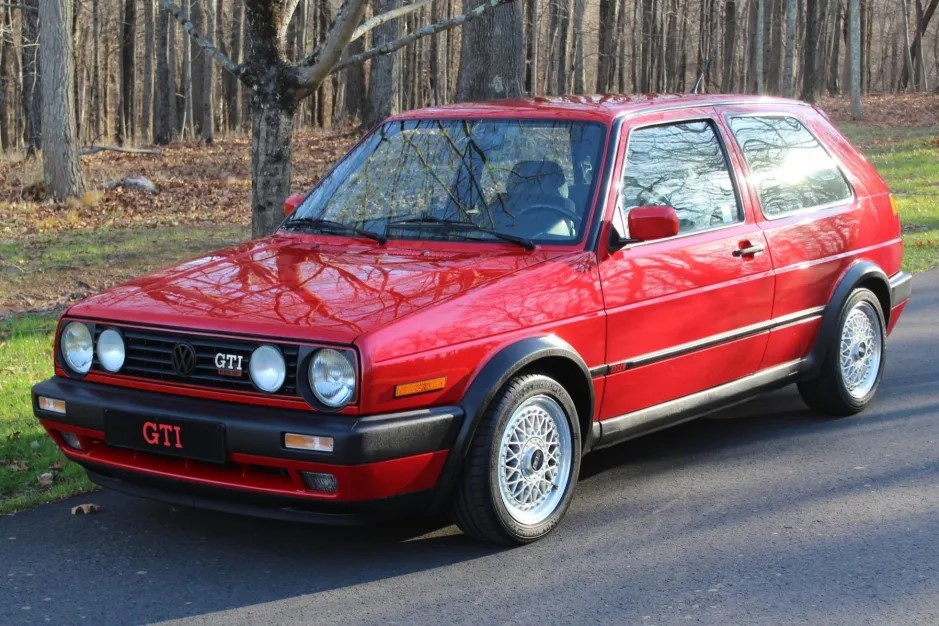
Current average value: $21,500 – 23,300
Projected growth: 23%
Despite a couple of outliers—including an $87,000 (!) sale (plus fees) early in 2023—the Mk 2 Volkswagen GTI, particularly the later 1990 – 1992 model, remains one of the best bangs for the buck. Its 139-hp 16-valve 2.0-liter and front-wheel-drive tossability continued to set the standard for the hot-hatch segment established in 1976 by its Mk1 progenitor*. Those outlier figures (decent Porsche 993 money) indicate that there is a growing appreciation for well-maintained unmolested examples beyond VW loyalists. Expect those exceptional examples to float all boats and see steady growth across all conditions.
* with all due respect to the 1971 Autobianchi A112 Abarth and 1973 Simca 1100Ti
1973 – 1980 Mercedes-Benz 450 SLC
Current average value: $19,750 – 22,400
Projected growth: 8%
The Mercedes-Benz SLC has always been a bit of an odd duck. It was designed to fill the spot being vacated by the W111 coupé, but rather than base it on the S-Class, as previous coupés had been, it was a derivative of the R107 SL roadster. It was, and remains, the only time that Mercedes-Benz would not base its “personal luxury coupé” on its flagship sedan. Power comes from the same 4.5-liter V8 as in the roadster, rather unfortunately bogged down by US emissions to a sluggish 160 hp (down more than 50 from its RoW counterpart). The idea of a four-seat hardtop 107 never really resonated with buyers, who didn’t seem to mind two-seats (or opted for the mostly unusable kinderseat) in favor of wind-in-the-hair motoring. Mercedes-Benz took note and with the 126-S-Class, returned to the big-bodied coupé that continued through to the C217 of the last generation. But that also means that they can be overlooked in the collector market as well. With their roadster counterparts regularly selling at over $30,000 and climbing (some low-mileage 560s approaching Pagoda money), the SLC lurks as a potential bargain.
2002 – 2004 Chevrolet Blazer ZR2
Current average value: $17,500 – 19,600
Projected growth: 12%
It’s widely accepted that most SUVs sold today will never see dirt, much less do any serious off-roading, even those that have been kitted with off-road packages. But Chevrolet didn’t accept that when they outfitted their workaday [S10] Blazer with the ZR2 package (introduced as an option package on the S10 pickup two years earlier). Available only as a 2-door, the Blazer ZR2 included a ladder-type frame with modified mounting points and a 3.9 inches wider track than the regular Blazer, increased ground clearance (approximately 3” over Blazer), enhanced front (7.25” ring gear) and rear (8.625” ring gear on 2002 – 2004 model years) axles, 31” x 10.50” BF Goodrich Longtrail tires, Bilstein shocks, a rear anti-sway bar, skid plates, and fender flares. There was no intention of seeing the ZR2 as a grocery-getter. There aren’t any reliable numbers of how many were made, but they seldom come on the market. Demand, so far, is well ahead of supply, which promises continued appreciation for examples that haven’t see too much off- or on-road abuse.
2000 – 2006 Audi TT Quattro
Current average value: $14,700 – 22,400
Projected growth: 3%
As we say goodbye to the Audi TT, which ended production in November 2023 after a 28-year run across three generations, let us not forget the mark it left, particularly in automotive design. With its concept-car looks, the production Audi TT arrived to broad acclaim for its rounded Bauhaus-inspired shape and respectable performance. Among its countrymen, the BMW Z3, Mercedes-Benz SLK, and Porsche Boxster, the TT was the only one available in both roadster and fixed roof configurations (for a time anyway), along with the legendary Quattro all-wheel-drive system. That said, the TT is and has been unfairly grouped with those more sports-car or sports-car-adjacent athletes. It’s the charming actor playing the part of the athlete, convincing enough in its performance, but its looks are what get the audience to buy the ticket.
2006 Porsche Cayenne Turbo S
Current average value: $21,300 – 23,250
Projected growth: 8%
Of the first-generation Porsche Cayenne (E1 or 955/957) variants, it’s the 2006 Turbo S that is by far the sexiest and most desirable. Built for just one model year in the pre-facelift E1, the Turbo S put out a whopping 520 horsepower, capable of a 0-60 time of 4.9 seconds, while its standard adjustable air suspension allowed the 2.5-ton car pull .873 g on the skidpad. The E1 Cayenne has long been sought after for its transfer case and low-range gear that had made its off-road capabilities on par with the esteemed Range Rover, while offering a genuine Porsche driving experience, particularly in the Turbo S. Closest estimates are that around 1,400 were made (600 of them finding their way to authorized dealers in the US) while fewer than 20 have come onto the market in the past year. Its fall from the original MSRP of $112,415 ($171,216 today) has been staggering, with higher-mileage but perfectly good examples selling for a tenth of that. However, at 18 years old, it has likely found the bottom and in some eyes has begun making the transition from attractive used car to interesting semi-collectible.
OR
2004, 2006, 2008 Volkswagen Touareg V10 TDi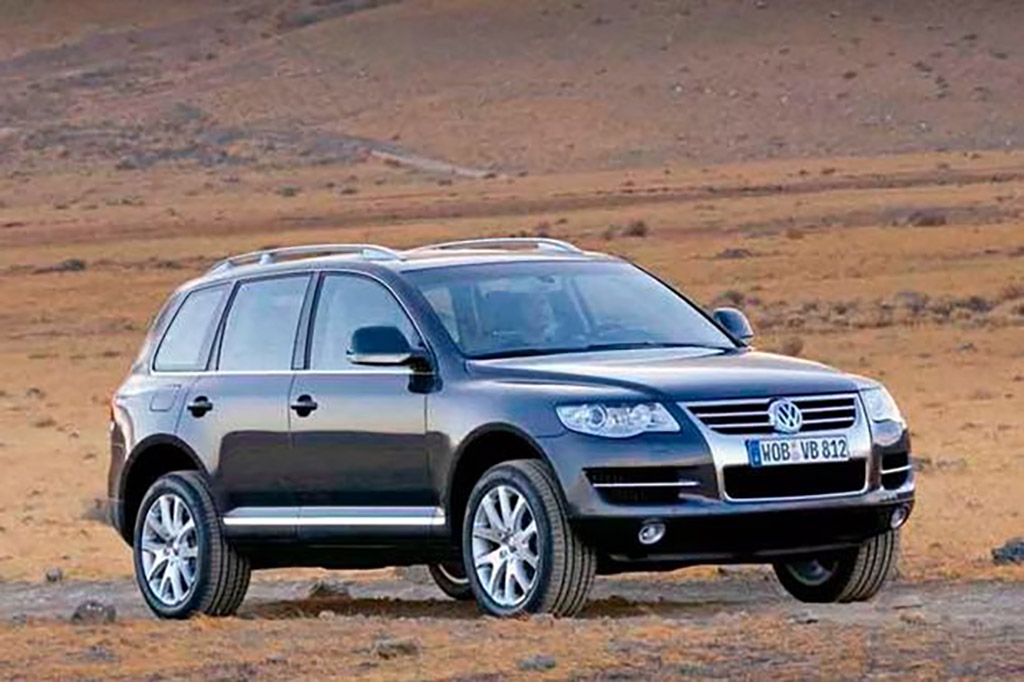
Current average value: $21,300 – 23,250
Projected growth: 8%
Sharing its platform with the Cayenne, but substituting the 520-hp turbocharged V8 for a turbocharged V10 diesel capable of 550 lb-ft of torque, the Volkswagen Touareg had to tap dance around US emissions such that they were offered for only three years: 2005 (as a 2004 model to comply with the aforementioned regs), 2006, and 2007 (as a 2008 model compliant in only 43 states). This makes them relatively rare (estimated around 1,100 combined), but few who bought them had exclusivity in mind. As such they were regularly driven and of the dozen or so that come onto the market in a given year, the majority have seen some miles, albeit in fine condition and given it’s a diesel, have many miles left to see. There are however one or two that have been driven sparingly and look the part. These examples have nowhere to go but up (often at 45°).
1987 – 1991 Volvo 780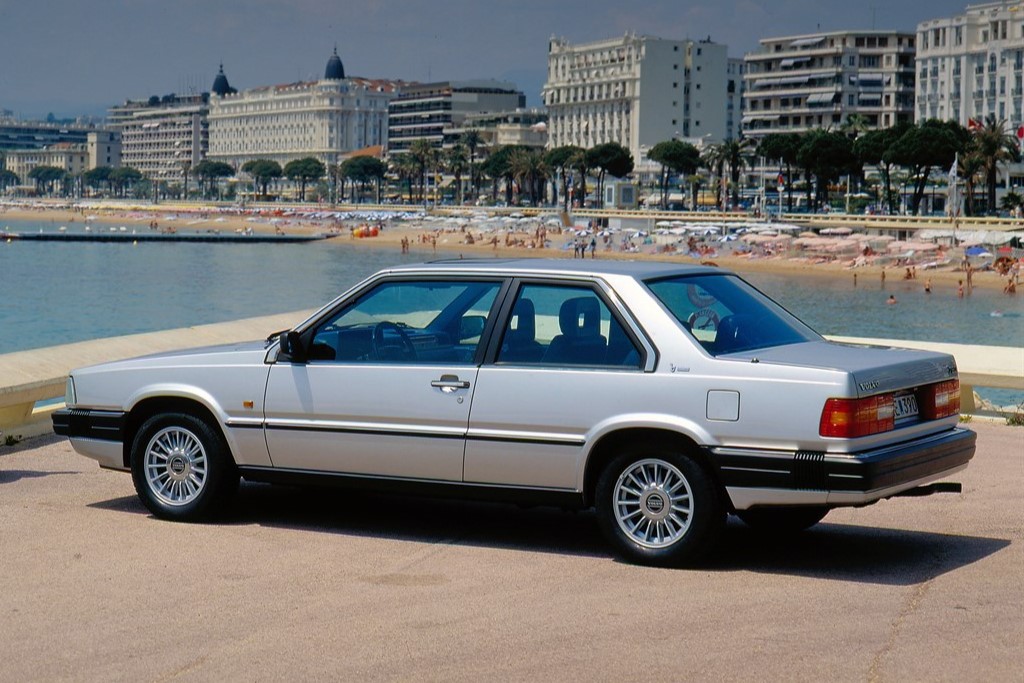
Current average value: $9,750 – 11,800
Projected growth: 16%
The mid 80s were a heyday for the personal luxury coupé, led by the Germans with the BMW 6-Series and Mercedes-Benz 500/560 SEC, along with the Lincoln Mark VII and Cadillac Eldorado. No one could blame Volvo for wanting a piece of it. While they’d always had a two-door version of the previous 1- and 2-series sedans, their three-box 740 and 760 were only available as sedans or wagons. Continuing the relationship with Italian design house Carrozzeria Bertone that brought us the chop-top 262C in the late seventies, the 780 was born. But unlike the 262C, which was essentially a richly appointed 2-door modification of a 264, The 780 was a unique model, both designed and built by Bertone. It too went upscale to match its stylish looks with lounge-like interiors and, by 1990, a turbo motor putting out 188 horsepower. While down on its competitors on a spec sheet, real-world performance was adequate and maintained the efficient sensibility of a Volvo. The 780 (renamed simply Coupe in its final year) wasn’t cheap. By the end of its run, its price had climbed to over $40,000 (in 1990 dollars; around $94,000 today). It is relatively rare, with roughly 5,700 copies coming to the US over a six-year span (less than 1,500 of them the Gen-3 Turbo models of 1990 and 1991). And yet, its value today places it among its far more common sedan and wagon 740/760 stablemates. With ’80s- and ’90s-era Swedish cars in general seeing appreciating values (see Saab 99/Classic 900 Turbo, Volvo 140/164/240/260), the 780/Coupe can’t be overlooked for much longer.
2002 – 2004 Ford SVT Focus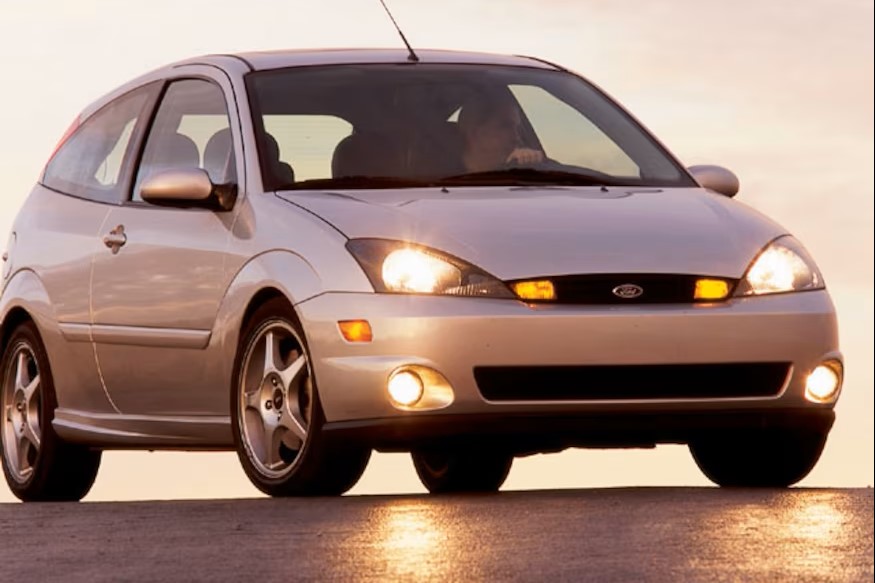
Current average value: $20,500 – 23,500
Projected growth: 19%
Taking its queue from the success of the Volkswagen GTI and Honda Civic Si, Ford introduced its own hot hatch in 2002—the Ford SVT Focus. It took the basic Focus ZX3 of the day and gave a Cosworth tweak to the ZX3’s 16-valve Zetec four, adding 40 more horses, and mated it to a Gertrag 6-speed gearbox, good for a run to 60 from a standing start in under 7.5 seconds. The performance gain was countered with better stopping power in the form of bigger brakes, bringing the car to a stop from that 60 mph inside of 122 feet. The suspension got tightened up considerably, while 17″ wheels were shod with 215/45ZR rubber. Its styling, though, remained relatively sleeper, with revised bumpers, rocker panels, and a mesh grille. Inside, the SVT Focus got white-faced, black-numbered instruments, a sportier steering wheel, aluminum-clad foot pedals, and sport seats with extra-deep thigh and torso bolsters. It all added up to $5,060 over the cost of a base ZX3 at $17,995. Around 14,000 SVTs were made between 2002 and 2004 in both 3- and 5-door variants. Not particularly rare, but far from mass-produced. With a 345-mile example selling recently at $29,000 plus fees, the few that come on the market will begin to get noticed.
1992 – 2000 Lexus SC400
Current average value: $20,500 – 23,500
Projected growth: 19%
When Toyota launched its upscale brand in 1990 with the Lexus LS400, there was no doubt it would put a dent in the European’s dominance in the North American luxury car market. Refined appointments and exquisite build quality met Japanese reliability and it was an immediate success with both the public and the press. Lexus followed it up a year later (as a 1992 model year in the U.S.) with a two-door coupé, the SC400 (and later the I-6 SC300), and it too went on to high accolades, including Motor Trend’s Import Car of the year and Car and Driver’s 10 Best for several years running. While they had never lost their ’90s appeal or popularity, the SC400 didn’t catch the attention of collectors in the following decades. A quality SC with around 50,000 miles could be had for well under $10,000 ten years ago. But that’s changing. There’s a renewed appreciation for its elegant yet sporty styling—largely driven by children of the ’90s—but also a keener interest in Japanese cars generally, and in particular, those with more sports or grand touring intentions. Even though the automatic-only SC400 would not nor should not be called a sports car along the lines of its progeny, the LC500, they were—and remain—a comfortable, capable means of enjoying the B-roads. As with any collectible, mileage sets value, but there are enough examples with reasonable miles (under 50,000) still inside of $23,000. But perhaps not for long.
1994 – 1996 Nissan Hardbody SE-V6 4×4
Current average value: $20,500 – 22,700
Projected growth: 19%
Introduced in 1985, the Hardbody is one of the most significant trucks in Nissan’s U.S. history. Building on the dependable, rugged, and versatile reputation of its predecessor, the 720, the Hardbodies (referring to the truck’s double-wall bed and overall styling) had a more modern exterior design with smooth, flush body surfaces and a spacious-feeling cabin helped by large windows. It would continue to evolve with minor facelifts and revised engines. Peak Hardbody came in the form of the 1994 – 1996 models years with the SE-V6 4×4 (in the US, where new OBD II regs would cut the life of the V6 short by a year). While the more common XE trim is perfectly capable, the SE was nicely appointed with standard auto-locking hubs and limited slip, along with alloy wheels, chrome trim, pop-up sunroof, sliding rear window, bedliner, air conditioning, 100-watt AM/FM/cassette, power windows and locks, cruise control, and a leather-wrapped steering wheel, among other comfort and convenience features. When new, the SE-V6 King Cab 4×4 was comparably priced to the Toyota SR5 4×4 Xtra Cab, but has trailed it in recent sales. However, with over 70% fewer on the market over the last five years, that trend may equalize or even reverse.
1998 – 2000 Mercedes-Benz C 43 AMG
Current average value: $20,800 – 23,700
Projected growth: 9%
Mercedes-Benz upped the ante in 1998 in its ongoing battle with BMW’s M3. Taking advantage of its newly acquired majority stake in German tuner AMG, they dropped a 4.3-liter V8 engine into its compact C-Class sedan. This gave it an over 60-horsepower advantage over the E36 M3 (US models with the comparatively anemic S52 motor), propelling the Baby Benz to 60 mph in under six seconds with a top speed of 155 mph. These figures are comparable to the M3 and would have likely benefitted from a manual gearbox (not available on US models). Best of all, the performance is cradled in the comforts of a Mercedes-Benz. The W202 C43 AMG is relatively rare with less than 1,500 coming off the line (the first AMG car to be built entirely at the Mercedes-Benz factory). This compares to over 12,000 E36 M3 sedans, which Hagerty values at $48,700 in No 2 condition. The MY2000s are particularly rare, with only 91 built, and they have the added benefit of the 5G-Tronic Speedshift auto-manual gearbox. But a C43 AMG from any production year would be a unique and enjoyable motoring investment.
2013 – 2016 Scion FR-S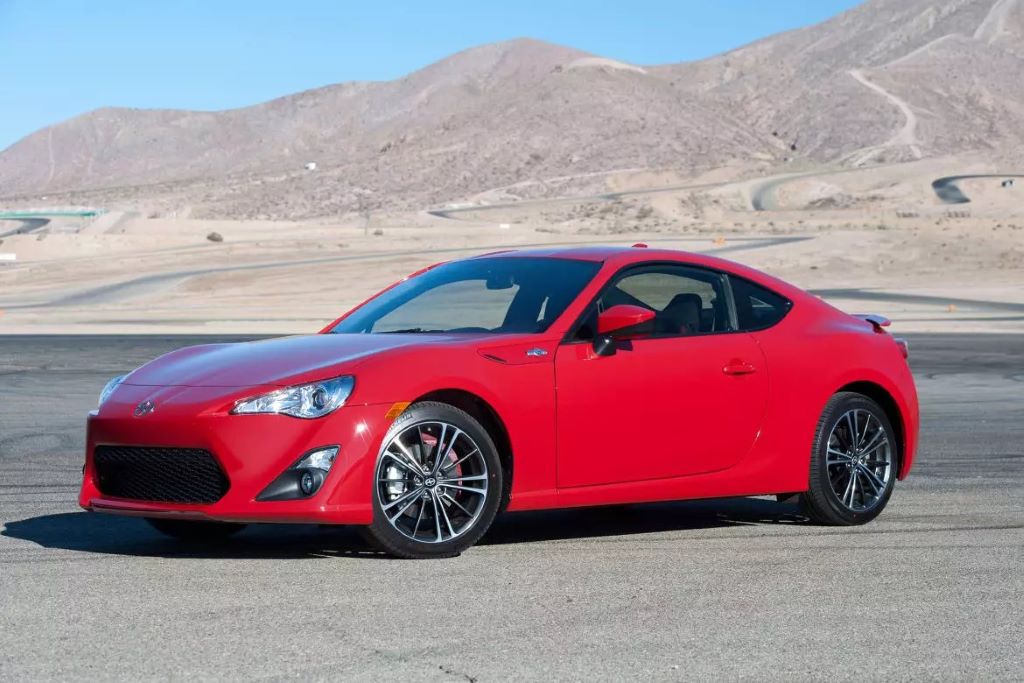
Current average value: $18,500 – 23,900
Projected growth: 8%
After a 7-year absence from anything resembling a sporty car, Toyota, in collaboration with Subaru, introduced the Toyota 86, or as we knew it the Scion FR-S (Front-engine Rear-drive Sport) for the 2013 model year. It was instantly celebrated as a reasonably affordable enthusiast car with excellent handling and a peppy 200-hp boxer engine. It was on a number of 10-best lists throughout its run, which continued into the second generation as the Toyota GT86 and more recently the GR (Gazoo Racing) 86 (along with its twin, the Subaru BRZ). There were several special editions, but they were well-equipped to begin with with standard 17″ wheels, MacPherson strut front suspension, double-wishbone rear suspension, a Torsen limited-slip differential, a Pioneer 300W radio with iPod connectivity, and wireless Bluetooth (a rearview camera and seven-inch infotainment touchscreen were added in 2016 models). They were aimed at a more youthful target, anticipating and allowing for modifications, going as far as hosting the Scion FR-S Tuner Challenge around its launch. Yet in stock form, they were youthful without going overly boy-racer and this is what gave them the broad appeal they enjoy today.
2011 – 2014 Ford Mustang GT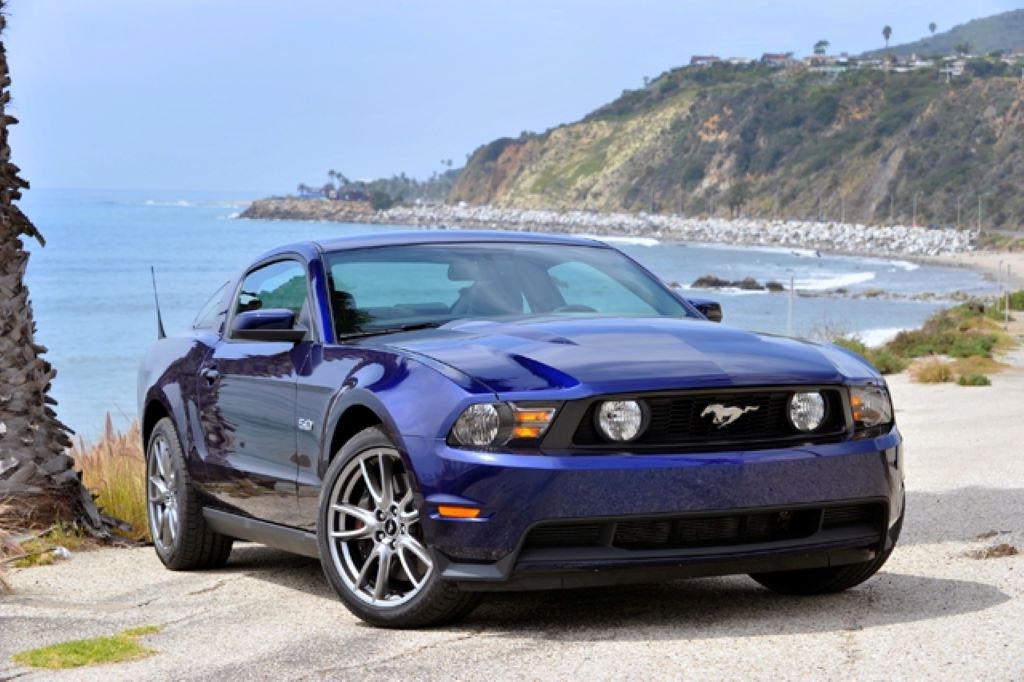
Current average value: $23,500 – 28,000
Projected growth: -12%
2024 promises to be the year that the depreciation curve on the fifth-generation (S-197 II) Ford Mustang GT drops below $25,000 for a well-sorted unmolested example. Excellent driver-quality examples have already dipped below the $20,000 mark in 2023. The S-197 II was a significant leap for the Mustang brand, returning to the legendary Five-Point-O with a brand new Coyote V8 in 2011, widely seen as the best engine Ford ever made. Now putting out 412 horsepower (nearly 100 more than the S-197) and 390 lb-ft of torque (65 more), this was not only keeping up with (and outpacing) direct competitors the Chevrolet Camaro SS and Dodge Challenger SRT-8, but it got the attention of would-be buyers of the Audi S5, Mercedes-AMG C- and E-Class coupes, even Maserati GranTurismos (the sonorous Detroit soundtrack doing much of the attention grabbing). Base price was $30,495. Options and packages could easily add another $10,000, but that was still less than a basic BMW 335i. There were enough made (nearly 100,000) that with some hunting and patience, a decent mileage, unmodified, Brembo-equipped S-197 II can be found for under $24,000.
1983 – 1985.5 Pininfarina Spider Azzurra
Current average value: $18,800 – 23,750
Projected growth: 19%
On paper it didn’t make much sense. In light of waning interest in roadsters (at the time) while facing increasing pressure from Japanese sports cars like the Datsun 280ZX and Mazda RX-7, not to mention hemorrhaging finances, Fiat elected to withdraw entirely from the US market. But Pininfarina, who had been producing the coachwork for the Fiat 124 and 2000 Spiders since their introduction in 1966, decided that, rather than lose that business, it would take over full production of the vehicles for two years, encouraged in no small part by the persuasive automotive ringmaster, Malcolm Bricklin, who would import and market the Spiders under his newly formed company, International Automobile Importers (the same arrangement was made with Bertone for the X1/9). Amazingly, it worked. The limited number (an estimated 3,500 made between 1982 and 1985) and better build quality from a dedicated line put these cars in a sort of “baby Ferrari” class and the venture was profitable (it was killed by another 24 for 24 for under 24 selection, the Cadillac Allanté, which was also designed and built by Pininfarina. GM executives suggested that a $14,000 former Fiat would take away the Pininfarina cachet from their new $55,000 SL competitor). It’s estimated that, like all Fiat Spiders, use, abuse, and neglect have left between 1,000 and 1,500 PininSpiders in saleable condition. Put another way, more rare than the Pininfarina-designed Ferrari 308 GTB/S of the same period, which routinely sells in the six figures.
1981 – 1987 Audi Coupe GT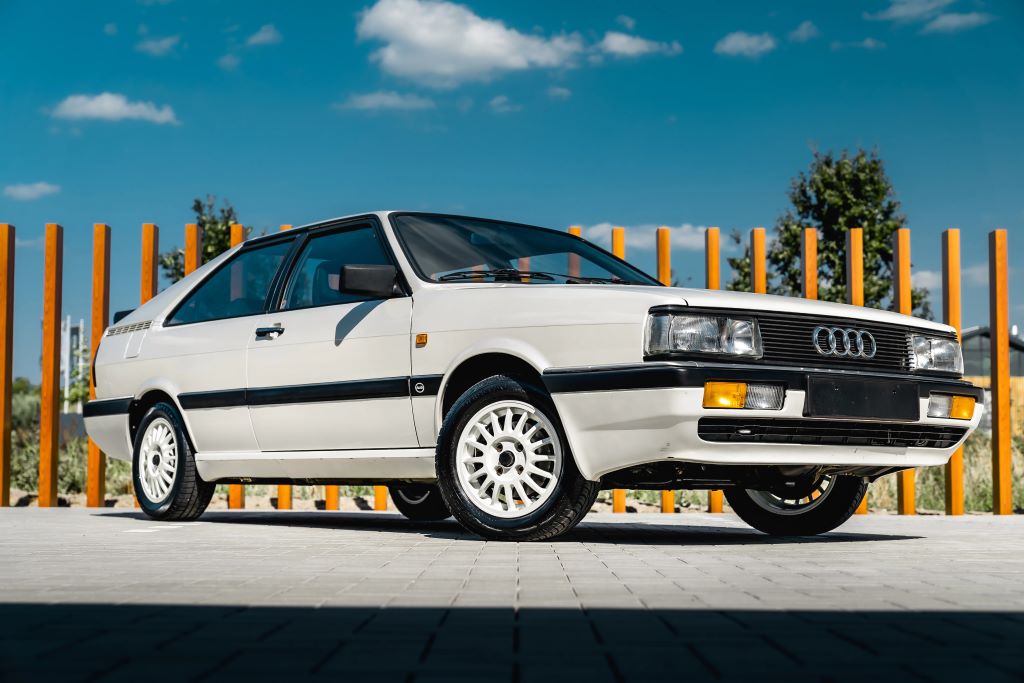
Current average value: $14,500 – 18,750
Projected growth: 12%
You would be hard-pressed to find any automotive enthusiast who doesn’t have a certain regard for the Audi ur-Quattro, the homologated version of the turbocharged four-wheel-drive coupé that dominated world rally in the early ’80s. It singlehandedly moved Audi from sedate Teutonic but upscale family car to a motorsport powerhouse that will see a Formula 1 entry in 2026. Lesser known is Audi Coupe GT, a more sedate (naturally aspirated, front-wheel-drive), Teutonic (no box-flared fenders) yet sporty two-door fastback. Introduced to American buyers in late 1981, the Coupe shared its drivetrain with the earlier 4000 5+5 two-door notchback (tip: find one, buy it), combining a peppier-than-it-sounds 100-hp 2.1-liter inline-5 with a 5-speed manual gearbox, enough to move the circa 2,500-lb car to 60 in 10.5 seconds and on to 109 mph. 14″ alloy wheels and low-profile tires contribute to the Coupe’s excellent handling. Minor changes were made throughout the early years and in 1985, a facelift, which in addition to better-integrated bumpers, smoother lower body panels, a sloped grille and flush headlamps, would add an additional 100 cc’s and 10 horsepower, resulting in a 0–60 in just over 9 seconds. Respectable for the day and even though the public never caught on, the automotive press loved it. Road & Track had dubbed this Audi “the best sports coupe” in its August 1981 “10 Best Cars for the Eighties” issue, and, in May 1985, Car and Driver would call it “the automotive equivalent of the natural athlete.” Despite nearly 170,000 Coupes made between 1981 and 1987, very few come up for sale (about a third as many as the ur-Quattro, which itself doesn’t exactly flood the market). It’s a sporty yet civilized German coupé with a World Rally pedigree for Scirocco money.
1991 Lotus Elan SE (M100)
Current average value: $17,500 – 22,250
Projected growth: 6%
Toward the end of the ’80s, there was a renewed longing for the kind of lasseiz-fare, wind-in-your-hair open motoring that was popularized in the ’50s and ’60s. That type of small, affordable roadster had been, for the most part, missing from the automotive landscape for most of the decade (the Alfa Romeo Spider the only notable exception). Mazda took note of this and, with the success of the retro-inspired RX-7 in 1979, was set to recall that essence with the MX-5 Miata in 1989. Around the same time Mazda was taking its inspiration from ’60s roadsters—chief among them the Lotus Elan—Lotus was developing a new Elan, the M100 (or 1990s Elan). With a healthy cash infusion from its sale to General Motors in 1986, the M100 went from concept to production in just three years. Under the guiding principle of founder Colin Chapman, who died suddenly in 1982, “simplify and add lightness,” the new Elan uses a fiberglass body over a Lotus-tuned Isuzu drivetrain. The result is a 1000 kg roadster with a 16-valve DOHC 1.6 litre motor putting out a respectable 155 hp and capable of a 7.5-second 0-60 time. Styling was decidedly forward looking, with queues of it still present in the current Emira. It’s finest quality, however, is its handling. Because of the limitations of GM four-cylinder drivetrains, Lotus was forced to use front wheel drive. However, despite—or perhaps because it—the Elan offers excellent grip with minimal understeer and steering thanks to what Lotus called “interactive wishbones.” This, combined with its light weight, makes for a very tossable, balanced package. What may be most impressive about the Lotus Elan M100 is that despite being a mass-market roadster developed with the US in mind, only 559 were sold here. A high price vis à vis the MX5, during a recession at its introduction, along with a limited dealer network simply could not provide enough return. It does however make for an interesting choice for both collectors and those who desire a unique, honest sports car that draws directly from its heritage with sensible, modern looks, performance and reliability.
1985 Bitter SC
Current average value: $18,700 – 22,900
Projected growth: 9%
The Bitter SC was the coupé version of Erich Bitter’s Opel-based coachworks, with an unmistakable resemblance to the Ferrari 400/412. It was powered by Opel’s 177-hp 3.0-liter inline six and was intended to be an alternative to the likes of the BMW 6-Series and Alfa Romeo GTV6 (182 hp and 154 hp, respectively). To complement the stylish bodies (that have aged remarkably well), the handmade interiors were sourced from Italy from leather maker SALT. Albeit more expensive (around $50,000 in 1985, compared to the BMW 635 CSi at around $42,000), it was far more exclusive, with only 461 SC coupés produced worldwide between 1982 and 1986 (233 of them making their way to North America). Despite their rarity, the few Bitter SCs that have come on the market in the last year have sold well below their BMW counterparts, but then therein lies the opportunity to acquire a very unique, very stylish German-designed, Italian-bodied, Austrian-built sports coupé.
1989 – 2003 Laforza
Current average value: $15,000 – 18,500
Projected growth: 8%
The thought of the Ferrari Purosangue may rile the feathers of a few Modena purists, but the idea of an Italian SUV is nothing new. Case in point, the Laforza, often referred to as a Ferrari 4×4 (albeit the only tie to Ferrari is its designer, Tom Tjaarda, who, while at Pininfarina also designed the Ferrari 330 GT 2+2 and 365 California). The Laforza started life in the mid-1980s as the Magnum, an SUV built by Rayton-Fissore, an offshoot of Carrozzeria Fissore. The Magnum was marketed as a luxury SUV, when there was only one other (hard to believe these days), the Range Rover. With a bolt-load of Italian leather, exotic wood, plush carpets, and a state-of-the-art (for its day) sound system, the Laforza carried its five passengers in a voluminous cabin (9 inches wider than the Range Rover) in Cullinan style. Its size however, even with the 5.0-liter Ford V8 supplied for and in the US (final assembly in Brighton, Michigan), meant that early models were sluggish. To some that was of no consequence, but in light of new competitors (Cadillac Escalade, Jeep Grand Grand Wagoneer, Toyota Land Cruiser), the Laforza received an updated 5.0-liter V-8 from the Ford Explorer along with a more modern full-time 4WD system (albeit without low gears). An optional Eaton supercharger bumped out from 215 to 320 hp. Torque stood at a burly 350 lb-ft. Despite these updates, the Laforza remained obscure. And expensive. By 2000, its base price (before the $7,000 supercharger) was $60,000 ($107,000 today), comparable to the more prestigious Range Rover at $59,875. By 2003, it was a nearly 20-year-old design without any major updates. While that worked (still works) for the Mercedes-Benz G-Wagen, the Laforza had simply become outdated (example: the last new vehicle offered in the United States without airbags). Today, its understated simplicity is part of its appeal. Combined with high-quality materials that still exude a sense of opulence, it makes the Laforza a lot (over 5,200 lbs worth) of car for the money.
1995 – 1997 Jaguar XJ6 Vanden Plas
Current average value: $11,500 – 15,000
Projected growth: 14%
The X300-generation Jaguar XJ is a perfect example of a car that still has a whiff of old money, but doesn’t require an endowment to afford. Particularly in the highest trim level, the Vanden Plas (or VdP in Jagspeak), there’s something of the family heirloom about it. Experts have called it “the last proper saloon made by Jaguar.” Unique to the VdP are its longer (by 5″) wheelbase, the trademark knurled front grill and trunk lid chrome spear, 20-spoke 16″ wheels, additional chrome trim and mirrors, heated windscreen, and a more luxurious interior with heated front seats, plush lambswool mouton carpets, extra legroom, contrasting piping, and burled walnut picnic tables for the rear seats. There’s a certain Prime Minister-y sense of being a passenger, or if you’re like the Queen and prefer to drive yourself, the 245-hp 4.0-liter inline-6 (the last in the renowned history of Jaguar inline sixes) and 4-wheel independent suspension should prove adequate. It’s a lot of grace, pace and space for the money.
1993 Cadillac Allanté
Current average value: $17,800 – 22,750
Projected growth: 0%
For the moment, the jury’s still out on whether the Allanté could be called a collectible, but they do have a following. They certainly have an interesting story. Perhaps how they were produced is as interesting as the final product. Bodies were designed and built by Pininfarina, then shipped back to Cadillac for final assembly, 56 at a time, using specially modified 747s. Naturally, this made for some significant overhead and made the Allanté the highest priced American production car of its day. With its original price at around $60,000, the open sports-luxury segment didn’t see enough incentive to be lured away from established company like the Mercedes-Benz SL or Jaguar XJS, despite these too being somewhat higher priced. Where the Merc was about simple elegance and the Jag was classically refined, the Allanté was about technology and edginess. There was some appeal to that, but moreso it was something that domestic—and specifically Cadillac—loyalists could opt for. That sentiment seems to carry over to today. Despite relatively low production numbers and Pininfarina roots, the Mercedes SL is still king of the lot, leaving the Allanté as an alternative to those who don’t stray far from Hamtramck. Even amongst them there is some debate as to which Allanté was best. Most gravitate toward the 1993 with its 295-hp 32-valve Northstar V8. The Cadillac Allanté isn’t for everybody and, with less than 21,500 built (about 20% of those in ’93), that’s probably a good thing.
2003 – 2009 Range Rover HSE
Current average value: $20,500 – 22,900
Projected growth: 12%
Blending lines of the classic Range Rover with inspiration taken from the Italian Riva speedboat, the third generation Range Rover (L322) has held up well some 20 years later. So well that much of its design can still be seen in the latest (L460) rendition. Developed under BMW ownership, the early (2003 – 2005) Series 3s were powered by BMW’s 4.4-liter V8 used in the X5, before switching to Jaguar power after acquisition by Ford (who had also acquired Jaguar in the deal). As heir to the first luxury SUV, the Series 3 had the added pressure of remaining the standard-bearer under what was quickly becoming a crowded field with BMW, Mercedes-Benz, Cadillac (and yes, Laforza) wanting a piece of that lucrative pie. The Range Rover did not disappoint with sumptuous leather, cut-pile carpeting, and exotic woods and aluminum that recall the aforementioned Riva speedboat. At the same time, it never forgets that it’s “the word’s best 4×4 by far” with a stiff new monocoque body, independent four-wheel suspension, permanent four-wheel drive with a two-speed on-the-fly transfer case and a torque-sensing center differential, air springs offering 11 inches of ground clearance at the touch of a button, Bosch-developed dynamic stability control coupled with ABS, four-wheel traction control, and hill-descent control. Yet on the road, where 90% of owners will employ it exclusively, its ride remains civilized and supple. Costing almost $80,000 ($115,000 in 2024) when new ($15K more for supercharging), it has seen its share of depreciation. Bummer if you bought one then, but a great opportunity for what Jeremy Clarkson has called “the best car in the world.” While values have remained flat over the last year, previous generations have seen double digit increases (11% for P38 and 12% for Series 1). 2024 is the right time to buy.
1975 – 1978 Ford Mustang II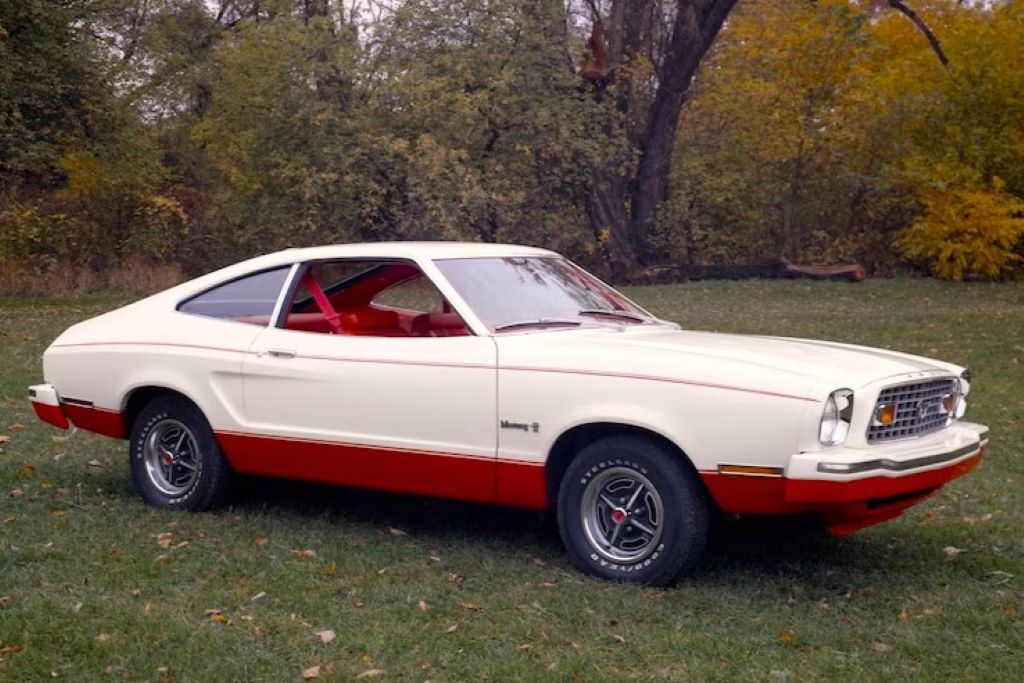
Current average value: $16,750 – 23,000
Projected growth: 7%
Let’s just get it out there. The Mustang II is the most important Mustang—and therefore one of the most important cars—of all time. Save your letters. It has been said that it was the right car for the right time, responding to the changing economic and cultural environment of the early ’70s. Yes but there’s more to it. Without it, there would be no S-197 II, let alone a 2024 Dark Horse. It was obvious that American buyers were gravitating in growing numbers to the smaller, more economical cars coming out of Europe (and increasingly Japan). Ford responded with the Maverick in 1970 and the even smaller Pinto in 1971. Meanwhile the Mustang kept getting bigger (or Grande if you will). It was on a path to extinction (the way of the Chevelle and very nearly the Camaro). Lee Iacocca, chiefly responsible for the development of the original Mustang, was now president of Ford Motor Company. As one of his first tasks, he ordered a small, economic car be built with the highest standards of fit and finish (a “little jewel” he’d called it) to carry on his baby, the Mustang nameplate. It can be argued whether the Mustang II succeeded in that endeavor, but what cannot be disputed is that without a bridge to the Fox-body that would once again restore the Mustang’s cred, the Ford Mustang would be a footnote along the lines of the AMX Javelin. They were nevertheless popular in their day but soon became a ’70s kitsch joke akin to polyester suits and 8-track tapes. The ensuing disregard meant that most were driven to the ground or have otherwise met their demise in a scrapyard. That said, there were enough made (1.1 million) that some nice original examples still turn up. They’re somewhat of a bargain compared to other generations, but as the Mustang celebrates 60 years in April, will the Mustang II get the credit it deserves?
1989 Chrysler TC by Maserati
Current average value: $9,100 – 11,600
Projected growth: 26%
To speak of Lee Iacocca, we must also speak of the Chrysler TC by Maserati. While at Ford, Iacocca began a friendship with Alejandro de Tomaso. Their first collaboration resulted in the DeTomaso Pantera. Now head of Chrysler, Iacocca and de Tomaso, now owner of Maserati, renewed their collaboration, this time to jointly develop a sports coupe-convertible along the lines of a Mercedes-Benz SL. After Iacocca’s idea of a Plymouth Reliant-based roadster was poo-pooed, they turned their attention to Iacocca’s personal favorite the Chrysler Lebaron. The result is the “TC” or Turbocharged Coupe. The TC was initially offered with the 160-hp Daytona-spec 2.2-liter Turbo II engine paired to a five-speed manual or three-speed automatic. It was called a “Maserati” engine because it was assembled by Maserati and has a Maserati-branded cast valve cover, however parts came from all over the world to assemble the motor. In 1990, a switch was made to a 141-hp 3.0-liter Mitsubishi V6 with a four-speed automatic. The bodywork was produced by De Tomaso subsidiary Innocenti. The struts and shock absorbers were specially designed for the car by Fichtel and Sachs, and a Teves anti-lock braking system was standard. The special wheels were made in Italy by the Formula One supplier Fondmetal. It ended up costing Chrysler close to $600 million. Doing the math, the cost to produce each of the 7,300 TCs was about $80,000 in 1990 dollars ($188,00 in 2024 dollars ). A disaster for Chrysler and Iacocca, but an opportunity to own and drive a relative rare, stylish, and fun-to-drive footnote of automotive history.
1964 Chevrolet Nova Wagon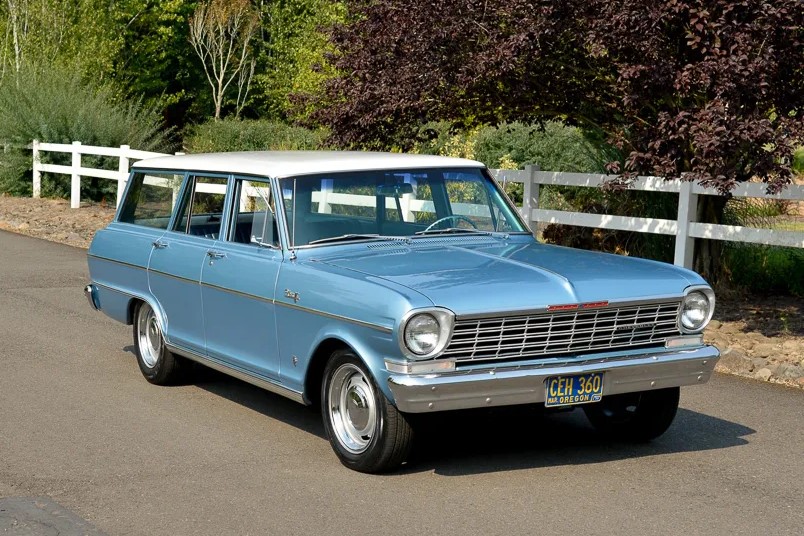
Current average value: $18,700 – 22,900
Projected growth: 9%
To some a SEMA-worthy custom rolling down the PCH is the ultimate expression of their love of cars. To others still, it’s a supercar unleashed on the Stelvio. Then there are those of us who find a certain—or great deal of—appeal in the sleeper, the humble, quotidian, unassuming outer shell, beneath which lies a spirited motor (I’m talking to you Ford Maverick). The Chevy II Nova, particularly in its longroof form, is a great example of that. With the arrival of the 195-hp 283 cubic-inch V8 in 1964, the Nova went from no va to ¡vamanos! Sure, 195 horsepower these days is midrange Hyundai territory, but combined with the its relative light weight (about the same as a Hyundai Elantra), the “small” Nova had some get-up-and-go (to use ’60s terminology). Furthermore, added weight in the wagon was biased toward the rear. As many would discover decades later (Paul Newman and David Letterman among them with their Volvos), the wagons offered significantly better handling than their coupé and sedan counterparts. Wagons also have the added benefit of being undervalued. Its an attractive combination in an attractive package. Just don’t tell anyone.
1993 – 1996 Honda Prelude VTEC
Current average value: $14,000 – 22,000
Projected growth: 25%
The Honda Prelude was one of those right car at the right time situations. It was introduced to the world in 1979 at the AutoRAI in Amsterdam, firmly planting the Japanese manufacturer in the heart of Europe. Take note Volkswagen, Opel, Renault. It was loosely based on the Accord, which had in its three-year existence established itself as a well-built, reliable, comfortable, and efficient runabout. The Prelude was positioned as the personal sports coupé on the world scene. By its fourth generation (BB1-BB4), it had grown into a technology advanced sporty-if-not-sports car with attractive styling, a lightweight chassis, and great handling. Power had grown from a relatively anemic 72-hp 1.8-liter CVCC to a much more respectable 190-hp VTEC (albeit gaining nearly 1,000 lbs over the first-gen SN. This is what laid the foundation for the Acura Integra Type R, an example of which sold at last year’s Amelia for over $150,000. It won’t be long before collectors discover just how impressive these BBs are.
Leave a Reply
You must be logged in to post a comment.